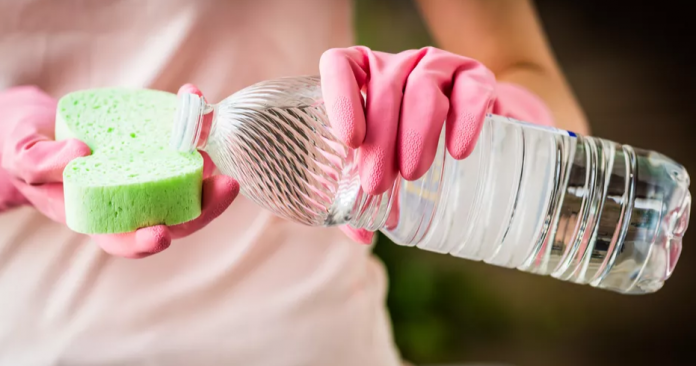It may be somewhat counter-intuitive that a liquid that can be said to have a fairly foul odour on its own can hold its own against the best household cleaners and odour eliminators. Yet many years of running a home have taught me that the acidity of good old white vinegar – often mixed with an equal amount of water – is an absolute beast for the dirt, grime and grease that accumulates in every nook and cranny of our homes over time.
Get out a bottle of vinegar and go on a journey with me; we’ll make your home sparkle and fresh in ways you never imagined.
Might as well start with the toilet
Most people start cleaning with vinegar by pouring it into a spray bottle, mixing it with water and spraying it all over the kitchen. It’s very good, I highly recommend it. But you don’t need me to tell you that vinegar can help you spruce up your countertops, backsplashes and cookers. You (probably) already knew that.
But vinegar can even clean the nastiest places in your home, including your toilet. If cleaning toilets with vinegar is good enough for Martha Stewart, it is for me. She offers these simple instructions:
Add 1/2 cup of vinegar to the toilet bowl, let it sit for a few minutes, scrub and flush.
If your water is hard, let the vinegar sit for an hour, and you may need to scrub lightly.
Decalcify your coffee maker
It’s fine to wash the removable parts of your coffee maker with hot soapy water after each use, but what about the inaccessible parts? Over time, hard minerals can build up in the deep, dark workings of your morning best friend, so once a month you can give it a deep clean – with vinegar. Good Housekeeping explains:
Fill the tank with equal parts vinegar and water, and place a paper filter in the empty basket of the machine. Put the jar in place, and ‘infuse’ the solution halfway through. Turn off the machine and leave it to stand for 30 minutes. Then turn the machine back on, finish brewing and empty the jar full of vinegar and water. Rinse it out by putting in a new paper filter and preparing a full pot of clean water. Repeat the process once.
House Beautiful says you can also do the same with your washing machine to remove any build-up. Simply add two to four cups of white vinegar to the machine and run a hot water cycle. Vinegar is also great for cleaning and deodorizing your dishwasher: Place a cup of distilled white vinegar upright on the top shelf, then run a hot water cycle with the rest of the empty dishwasher. Finish by sprinkling baking soda on the bottom of the dishwasher and run a hot, empty cycle again.
Spruce up the inside your kitchen cabinets
You probably wipe down the outside of your kitchen cabinets and drawers from time to time, but take a moment to stop and think: When was the last time you cleaned the inside of your cabinets? You may be very good at cleaning and do it regularly, but your answer is more likely to be something like “maybe the day I moved in”.
If that’s the case, here’s what I want you to do: Take a bottle of white vinegar and pour some of it into a spray bottle with an equal amount of water. Take out the dishes, note all the crumbs, dust, grease and grime that have accumulated over time in the cabinet, then start spraying. Wipe the mixture off with a clean cloth, and enjoy your new sense of self-respect.
Give your microwave a vinegar steam clean
Another thing we probably don’t clean as often as we should? The microwave. Not only does the inside of the microwave play host to any number of reheated food splatters, but odors tend to linger within, too. I don’t particularly enjoy sliding a bowl full of soup into a contraption that still smells of my reheated morning coffee, but maybe that’s just me.
Anyway, to deal with this problem, grab a microwave-safe bowl, fill it halfway with water, and then add a few tablespoons of white or apple cider vinegar. (You can also add in some slices of lemon or lime, if you’re feeling extra fancy.) Better Homes & Gardens tells us what to do next:
Using high power, heat the vinegar and water for up to four minutes until boiling. The amount of time to heat the water depends on the power of your microwave. Look at the stickers inside the microwave door—often times, your microwave’s wattage will be listed here. Here’s a handy list of microwave temperature cleaning times:
- 1,200 watts = 1 1/2 minutes
- 1,000 watts = 2 minutes
- 800 watts = 2 1/2 minutes
- 700 watts = 3 minutes
- 600 watts = 4 minutes
Although the risk of bubbling super-heated water is minimal, some experts recommend placing a wooden skewer or wooden spoon in the water for bubbles to form around, providing a release for built-up air.
Let the bowl of hot vinegar water continue to steam for a few minutes after the microwave goes off. Then remove the bowl (be careful; it’s hot!), take out the turntable and other removable parts (also hot!), wipe down the inside with a damp cloth, and wash the removable pieces separately.
Attack those dusty window blinds
Let’s get out of the kitchen for a bit, shall we? Because those window blinds are not going to clean themselves. Window blinds are great at providing privacy, and they are equally great at attracting and collecting copious amounts of dust and grime. Luckily, you have vinegar, so it’s not going to be a problem for much longer.
Here’s what you do, according to SelectBlinds.com:
- Fill a small bowl with white vinegar and find a pair of clean cotton gloves or socks.
- Put your hand inside one of the gloves or socks and dip the tip of the sock, or your fingers into the bowl.
- Run your hand or fingers along each slat to remove the dust and grime. You may need to rinse the sock or glove a few times.
- Switch back and forth between the two socks or gloves, soaking one sock or glove while you use the other.
You shouldn’t go overboard with the saturation here—especially if you have wooden blinds—but a damp swipe should dry pretty quickly without causing any damage. (Also, I’d probably add some water to that bowl of vinegar.)
Scrub your grout
Tile grout loves itself some dirt, but nobody enjoys the sight of dirty grout. However, Bob Vila says dirty grout is nothing a little vinegar can’t handle. Grab your half-vinegar, half-water spray bottle, douse the grout, let it stand for five minutes, and then scrub the dirt away with a stiff brush. If your grout is more than moderately dirty, you could add some baking soda to the equation:
To bring even more cleaning power to the party, cover grout lines with a paste of baking soda and water, then spray on the vinegar solution listed above. Once the mixture stops foaming, scrub with a brush and rinse with plain water.











